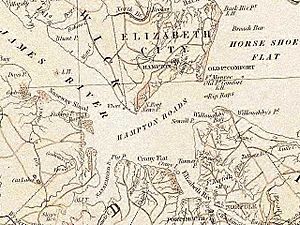Willoughby Spit facts for kids
Willoughby Spit is a piece of land shaped like a finger that sticks out into the water in Norfolk, Virginia, a city in the United States. Water surrounds it on three sides. To the north is the Chesapeake Bay. To the west is Hampton Roads, and to the south is Willoughby Bay.
Contents
How Willoughby Spit Was Formed
The area got its name from Thomas Willoughby, who came to Virginia in 1610. He received his first land grant (official permission to own land) in 1625. His son, Thomas II, lived there in the 1660s. A story says that his wife woke up after a huge storm, possibly the "Harry Cane" of 1667. She saw a new point of land in front of her house where there had only been water the night before! The Willoughby family quickly asked for more land to own this "new" property.
How Storms Shaped the Coast
Big storms and hurricanes kept changing the shape of the coast for over a hundred years. Even though official weather records for Hampton Roads only started in 1871, we know about earlier storms from old ship logs, newspapers, and writings from early settlers.
People living near the coast long ago really paid attention to the weather. For them, a tropical storm was a very important event because they often made their living from the sea. During a hurricane in 1749, the Chesapeake Bay rose about 15 feet (4.6 meters) higher than normal. This storm helped create a sand spit at Sewell's Point. Then, the Great Coastal Hurricane of 1806 helped form Willoughby Spit as we know it.
Protecting the Beach from Erosion
Over the next centuries, sand moved westward along the coast. This caused a lot of erosion on the 7.3-mile (11.7 km) long beach of Willoughby Spit and the rest of Ocean View. Homes and businesses built too close to the water were often in danger from coastal storms. Also, the beach was very narrow, which limited how much people could use it for fun.
The City of Norfolk started a project called "beach nourishment". This project involved adding sand to the beach. They also put in breakwaters, which are structures built in the water. These breakwaters help to slow down beach erosion and protect the shoreline. Thanks to these efforts, the coastline now has more beach for recreation and better protection from strong storms and hurricanes.
However, breakwaters are not a perfect solution. They can also change how sand moves. Beaches and coastal areas are naturally unstable. After Hurricane Isabel hit Norfolk in late 2003, the city had to add about 428,000 cubic yards (327,000 cubic meters) of sand. This cost around $3.8 million. Even with these costs, the growth in the area and more tourism bring in money that the region needs.
The water area between Sewell's Point and Willoughby Spit is now called Willoughby Bay.
Travel and Transportation
For many years, a ferry boat service ran between Willoughby Spit and Old Point Comfort. This ferry crossed the mouth of Hampton Roads. But in 1958, the first part of the new Hampton Roads Bridge-Tunnel was finished, and the ferry service stopped.
Today, the southern end of the Hampton Roads Bridge-Tunnel is at the tip of Willoughby Spit. This bridge-tunnel was made wider to four lanes in the 1970s. After leaving the bridge-tunnel, Interstate 64 (which is part of the Hampton Roads Beltway) crosses a small part of the spit. Then it goes onto a bridge over the northern edge of Willoughby Bay.
How the Area Became Part of Norfolk
The entire area of South Hampton Roads was first part of Elizabeth City Shire when it was created in 1634. A "shire" was an old word for a county. From this original county, New Norfolk County was formed in 1636. This new county was soon split into Upper and Lower Norfolk counties. Lower Norfolk County was then split again in 1691 to form Princess Anne County and Norfolk County.
The Willoughby Spit area stayed part of Norfolk County for over 225 years. In 1923, Willoughby Spit and the rest of the Ocean View area became part of the independent City of Norfolk. In Virginia, "independent cities" are like their own counties and have been around since 1871.
A Historic Flight
In 1910, a pilot named Eugene Ely made aviation history. He successfully launched his Curtiss biplane from a special deck built on the cruiser ship U.S.S. Birmingham. He then landed on the beach at Ocean View's Willoughby Spit. This made him the first pilot ever to take off from a ship!


